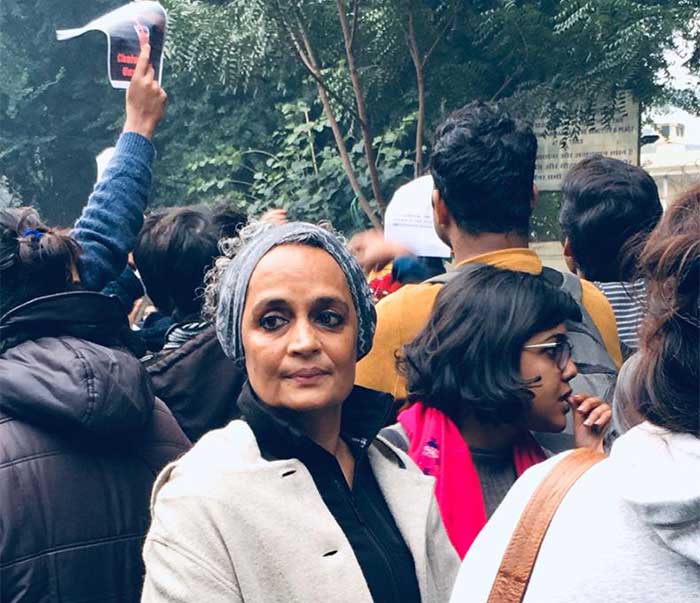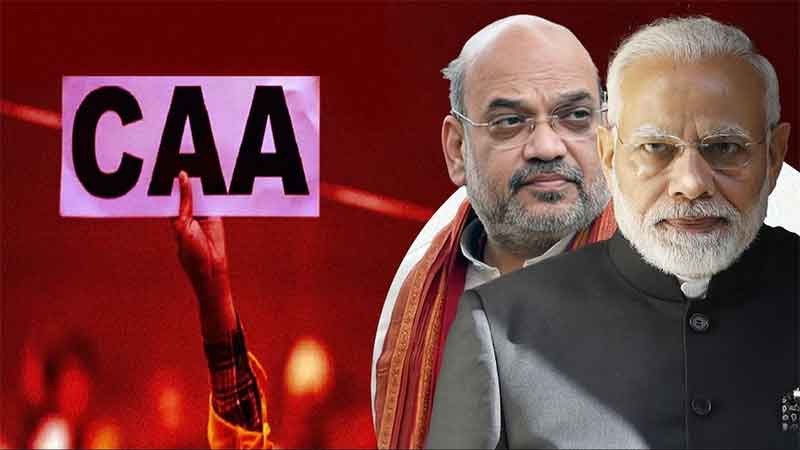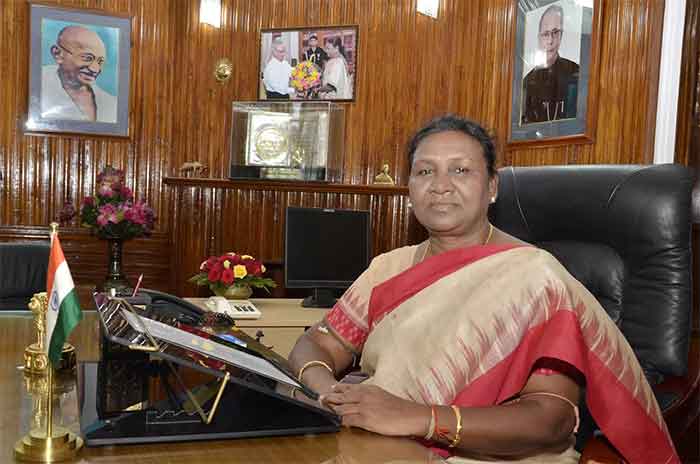
On December 19th, I left Batla House, Jamia Nagar to Lal Quila to see my city swell up in anger. The BJP-led government had passed the Citizenship Amendment Bill (CAB) and turned it into the Citizenship Amendment Act (CAA). When the students of Jamia Milia Islamia had protested against it, fearing for their own existence, the Police Force did the one thing they were trained and asked for— to spread fear. On December 15th, the day I turned 21, the Delhi Police Force attacked my University. They battled their way into the buildings, declared war inside the libraries, shed blood on books and research papers, broke flower pots, and injured more than 200 students— leaving many fractured, traumatised and one partially blind. The nation was furious, and hence they called for a nation-wide protest.
A good, old friend had once quoted to me—
Ishrat-e-qatra hai dariya men fana ho jaana,
dard ka had se guzarna hai dava ho jaana.
And hence, I left for the heart of the city to see and be a part of the pain. Among the crowd, I saw a quiet face, a head of grey curls wrapped around in a greyer bandana, her nose stud sparkling amidst all the furious noises, the loud posters and the cold Delhi air. As I stared at her, trying to fit her into a frame that would contain her, I lost myself in her calmness. She caught me staring, and threw across a pleasant, familiar smile, and then walked past me towards the group of impatient journalists and reporters who were waiting for her. I heard her tired voice behind me speak the same things she had been repeating for decades.
“Are we going to stand in line once again, obediently, and comply with this policy that eerily resembles the 1935 Nuremberg Laws of the Third Reich?”
Years ago, in 2014, when Kashmir was still undergoing its siege since the departure of the British rule, when we were in our homes, reading, eating, playing games in our backyard, probably only having seen and heard the sounds of gunshots in action films and thriller novels, Roy was up in the valley, travelling to Shopian to meet a man named Shakeel Ahmed Ahangar. Shakeel was in trouble with the police for having spoken about the brutal rape and murder of both his wife and sister by the army, who he had found lying down near a shallow stream in a high-security zone. Roy, awaiting a sedition case back in the capital for having said that Kashmir couldn’t be called an “integral” part of India, was on her way to Shopian the next morning, only to tell Shakeel that he wasn’t alone in his fight. I don’t know how many more Shakeels Roy has met, or how many of them have invited her to their home, cried over noon chai, and helped her write down the hundreds and thousands of atrocities done on the Kashmiri people every passing by the Indian Army Forces, but I know that—
We didn’t budge. We didn’t know any Shakeels. Our wives and sisters were safe. It was only Kashmir. It was way up north where it wouldn’t reach us.
On July 11, 2016, seven Dalits were lynched by a “cow-protection group” in Gujarat for skinning the carcass of a dead cow. The very job the founding Gods and Goddesses of the Caste System had bestowed upon them. Two years prior to the Una incident, Roy wrote a 158 paged essay called ‘The Doctor and The Saint’, narrating shocking events of the caste atrocities that had been happening in India, clearly warning us of the disgusting reality of the country we lived in, of the hopelessness in its political systems and institutions. She tried to introduce the much ignored reformer and scholar Dr. B. R Ambedkar to the world, in the hope that people would turn to the Truth, in the hope that people would recognise the elephant-sized monster in the room called Caste, that they would, for the sake of the empathy and humanity left in their blood, try and do their part. But—
We didn’t budge. We didn’t have Dalit friends or Dalit neighbours. That part of the media was something we didn’t want to turn to. We didn’t see, therefore we didn’t believe.
An year after that, in the May of 2017, two months after Yogi Adityanath’s victory in the U.P elections, he decided to visit the village of Mainpur Deenapatti in the Kushinagar district of Uttar Pradesh. But he was Yogi, and the people in the village were a part of the Musahar (Dalit) community. Even their shadows would pollute the atmosphere His Highness stood in. So he distributed Lifebuoy soaps and Ghari shampoos to “clean themselves” before he rolled the red carpet down the road of Mainpur Deenapatti to meet his dear Dalit friends, who now were Dalit friends who smelled like Lifebuoy.
In the March of 2010, Roy told us of her experience, walking with the people of Dantewada, Chattisgarh, otherwise also known as Maoists, Naxalites, or India’s Gravest Internal Threat. They were human beings who once lived in their homes. Then “development” came their way under the disguise of big dams, irrigation projects and mines, which had turned them into human beings in uniform. Over 50 million people have been displaced in India due to “developmental” projects in the last 50 years. Many lost their mothers, fathers, sisters, brothers, girlfriends and boyfriends in this war against the rich who already had sky-scraper sized homes named Antilla, but just couldn’t sleep in peace without displacing a few mud-houses and thatched houses here and there, to make more space for their big, booming businesses. Roy screamed and screamed at us about the government and their close friends— Ambani, Adani and Mittal, she told us about the army, the police, the Congress party’s Salwa Judum, the women they’ve raped, the children they’ve killed, the homes they’ve crushed, the destruction they’ve done to the entire tribal society which would take an entire generation or more to repair, if it was ever going to come to that.
Still, we didn’t budge. We continued to shop at Reliance, make calls with Jio, and wear Lakme on our eye-lids. We liked TATA’s iodized salt and Tetley Tea. The war was deep in the forests where it wouldn’t reach us. We didn’t have to worry.
Many many years ago, on a quiet night in the May of 2002, Roy could not sleep. She got a weeping call from Baroda that kept her up. A friend’s friend of her’s had been caught by a mob, had her stomach ripped open, stuffed with burning rags, and had died with ‘OM’ carved on her forehead. That night, she wrote, “Gujarat, the only major state in India to have a Bharatiya Janata Party government, has for some years been the petri dish in which Hindu fascism has been fomenting an elaborate political experiment. In March 2002, the initial results were put on public display”. Almost 2000 people had died in that pogrom. Narendra Modi easily patted his own shoulders and moved his way up to the centre.
We still didn’t budge. It was Gujarat’s problem. The Muslims of Gujarat will have to handle Modi, why should we?
Now Narendra Modi is in the centre. It took demonatization, GST, the Babri Masjid verdict, Abrogation of Article 370 and the destruction of Jamia Millia Islamia for everybody to shake their “apolitical” selves awake. Everybody budged because we couldn’t escape it even if we tried, because it happened right in front of us, because our news screens were filled with people we knew, people we had smoked cigarettes with, people who we sipped chai with, people we laughed and cried with.
When the students requested the Supreme Court to look into the matter and hold the violent policemen rightfully guilty, the Court said they didn’t have time to write down everything that was happening in India.
If the Supreme Court wasn’t going to write this, who else was going to do the writing for us?
Arundhati Roy turned fifty-eight last month. Her lungs hurt from all the decade-long screaming. Her fingers hurt from all the writing. She is not going to take a break now even if we owe her one. At least at this point, if we don’t take to the streets like she and a hundred others did years ago, if we don’t understand the war that is being fought in every corner of the country that slowly shook our conscience only when it moved to the heart of the urban population, if we don’t keep her God of Small Things aside and see her for the Goddess of Big Things that she really is, then we can confidently declare ourselves to be the most hopeless, blinded, ignorant generation the world will see.
When the War is being fought right in front of us, we can not afford to close our eyes. We mistake ourselves if we think they do not come for the sleeping, that they do not come for the blind.
This is our War. Along with Kashmir, with Una, with Dantewada, with the North East, this was always our war.
We were to fight it yesterday. But now, at least now, let us not keep tomorrow waiting.
Izza Ahsan is a student of Jamia Millia Islamia















































